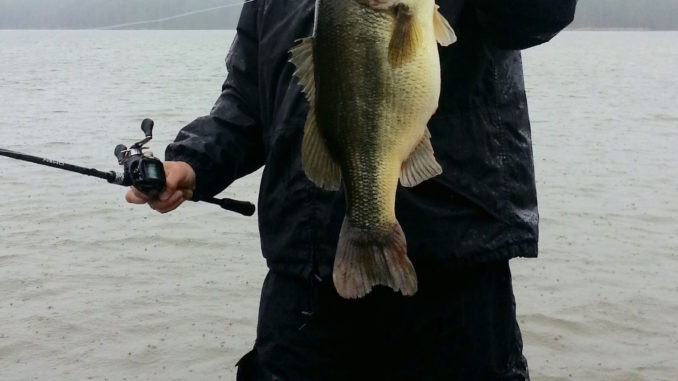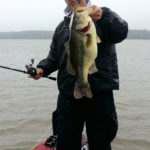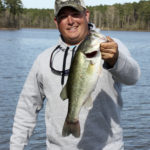
When Jordan Lake’s bass head shallow, be waiting for them. These experts explain where.
March madness is a different ailment for different people. For some, it’s a need for the heated rivalries between the college basketball teams they love and love to hate. For others, it’s the heating up of the shallow waters at B. Everett Jordan Lake south of the Raleigh-Durham area.
After waiting and chipping away at deep, lethargic largemouths through the winter, anglers will find bass staging on points, where they can cast a variety of reaction baits and have a heyday with hungry lunkers.
If you’re a bass fisherman, even if the winter has been relatively mild, the action pales in comparison to the spring rush, when anglers can pull out some of their old favorites and beat the banks. But a date on a calendar page doesn’t mean anything to Larry Largemouth, but certain numbers do.
“The water temperature has to start rising,” said Jonathan Phillips, a veteran bass fisherman from Pittsboro who fishes a number of area tournaments. “I usually see the best fishing when the water gets around the 55-degree mark, 55 to 58. When the water reaches that point depends on the weather in February and early March, but it can happen as early as the first week or the middle of March. Wind direction also plays a big factor. If we have a south wind blowing for three or four days into a pocket, it will load up in early March with fish pulling in there.”
“They’ll be coming up shallow, looking to spawn,” he said. “The first place they’re going to stop is the points; they’ll stage there before going into the creeks. But there are all types of points on the lake. The corners of the creeks are the main points, and then the secondaries are into the creek. It can be the corners of a pocket. They’ll also stop on the end of a grass bed; if it’s got a little wood in there, that makes it even better. The earlier in the year, the closer I like to be to the river channel.”
Covering more than 13,000 acres about 20 miles west of Raleigh, Jordan Lake is a relatively formidable body of water, with lots of likely prespawn staging areas. Phillips focuses his efforts on the upper part of the lake, the northeastern portion.
“The Farrington area turns on before the rest of the lake,” he said. “That’s the first place they start spawning. I try to stay away from the live creeks that have a lot of flow. They’ll be colder (than) those that don’t have current.”
Chadd Eriksen of Wake Forest, likes to fish down the lake, in the US 64 area.
“I like White Oak Creek,” he said. “It has a lot of shallow, muddy water with wood cover. It heats up fast and is one of the first places the fish will come to spawn.”
“The first and secondary points at the mouths of creeks are always huge,” Eriksen said. “But, at Jordan in particular, the bridges hold really good fish right before they move into the creeks to spawn. The rock around them absorbs heat. Up against the riprap, it’s got to be a little bit warmer. That attracts baitfish, and bass are going to feed up before the spawn.”
Phillips also uses rocks to guide him to bass in the creeks and pockets.
“A red-clay, chunk-rock bank is the key to look for,” he said, “just because it warms up and holds that heat. They want to get up there around those rocks where it will be a little warmer throughout the day.”
In addition to comfort, bass are happy to greet one of their favorite meals in the rocks.
“When the water is that temperature, the crawfish will be active,” Phillips said. “They’ll come out in the clay banks and rocky areas. Bass will be feeding on them before the spawn because they’re high in protein. It’s the same thing around the riprap.”
Phillips, who targets bass in 2 to 6 feet of water, chooses a Shad Rap to mimic crawfish and capitalize on their emergence.
“Earlier in the spring, I like to throw a No. 8 Shad Rap in crawdad colors,” he said. “Red produces really good on Jordan and the other Piedmont lakes. You want it to hit off rocks and run it around wood and the edge of grass. I throw it on 10-pound Seaguar InvizX.”
Another lure Phillips likes to bang the cover with is a spinnerbait.
“I’m slow-rolling the spinnerbait,” he said. “Let it bump the bottom and hit rocks. Sometimes you have to crawl it across the bottom, barely turning the blades to get bit. In a spinnerbait, you can’t go wrong with chartreuse. Early in the year, I like to use a Colorado blade and keep the bait in the ½- to ¾-ounce range. Hawg Caller makes a good spinnerbait. ER Lures spinnerbaits are really good, too; they’ve got a light wire arm and they bite them really well. Spinnerbaits are the best lure to catch a big fish on in the spring.”
Phillips, who fishes spinnerbaits on 15-pound fluorocarbon, uses a trailer hook to eliminate short strikes.
“You absolutely need a trailer hook, 100 percent of the time,” he said. “It may cause you to get hung up more, but I can handle getting hung up better than losing a couple of big fish.”
In addition to Shad Raps and spinnerbaits, Eriksen uses a ⅜-ounce Picasso Shock Blade to resemble another visitor to the shallows, the bluegill.
“It’s a vibrating jig, like a Chatterbait,” he said. “When the water is from 55 degrees up, I like to imitate bluegill more than shad. Bass always eat them, but it seems like around the spawn, it works a lot better. Bluegill aggravate the bass on the beds around their eggs.”
The Shock Block comes in a bluegill pattern that is a mixture of blue, orange and olive green. Eriksen fishes it and other reaction baits on 14- to 17-pound fluorocarbon line.
Should Mother Nature throw a curve, and a cold spring is on the plate, Eriksen will back off and fish the deeper drops off points, concentrating on deep laydowns. He throws the Shad Rap to imitate shad, as well as a suspending jerkbait such as a Smithwick Rogue or Spro McStick.
“You can catch fish all the way from 45 degrees to the spawn on a jerkbait,” he said. “It’s not always the case to deflect it off of cover, because it’s a start-and-stop retrieve,” said Eriksen, who fishes jerkbaits on 10-pound fluorocarbon.
“Ten to 12 fish is a good day at Jordan,” he said, “but there is such a good quality of fish there. If you catch 12 keepers out there, it’s going to be a good sack; it’s going to be pretty hefty. Especially in March when they’re in a prespawn mode, they’re going to be eating and healthy. The average size is 3, 3 1/2 to 5 pounds, a good size.”
Phillips said that prespawn bass will often be in a concentrated area, and finding a good one can lead to the mother lode.
“This time of year, when you hit a stretch where you catch a big fish or two, you can come back, fire it, and catch another one on the same bait,” he said. “They’ll keep pulling up in those areas. Most tournaments are won in a stretch; they just happen to catch 25 pounds in that stretch. You’ve got to fish the area and have confidence that there’s more fish there. Just grind it out and get everything out of that area.”
DESTINATION INFORMATION
HOW TO GET THERE — South of Durham and west of Raleigh, Jordan Lake can be accessed from a number of major roads. NC 64 crosses the lake east-west at mid-lake, with popular public ramps at Crosswinds, Seaforth, White Oak and Ebenezer Church within a mile of the causeway. To fish the upper end of the lake, Farrington Point access off Farrington Point Road is just a short hop from US 501 and NC 751, the latter the best connector from I-40. US 1 passes just to the east. For a complete list of ramps, visit http://www.ncwildlife.org/Boating/WheretoBoat.aspx.
WHEN TO GO — Jordan Lake’s bass make a concerted prespawn move to the shallows by mid-March, but the exact timing is subject to the weather. Fish will likely be on the move when the water temperature hovers in the mid-50s.
BEST TECHNIQUES — Bass in the prespawn mode will hit a variety of lures, including spinnerbaits, Shad Raps, square-bill crankbaits, jerkbaits and jigs; concentrated on crawfish, bluegill and shad colors. With the exception of jerkbaits, all lures should be dragged across the bottom and banged into cover to trigger reaction strikes. Go with a slow retrieve. Rocky or clay points near and inside creek mouths, riprap banks and boat ramps will be hot spots.
FISHING INFO/GUIDES — Jeffrey Thomas, Carolina Outdoors, 919-770-4654, www.carolinaoutdoors.net; Joel Munday, Outdoor Expeditions Guide Service, 919-669-2959, www.outdoorexpeditionsusa.com. See also Guides and Charters in Classifieds.
ACCOMMODATIONS — iChatham County Chamber of Commerce, 919-742-3333; Holiday Inn Express, Apex, 877-859-5095; Comfort Inn, Apex, 855-849-1515.
MAPS — Kingfisher Maps, 800-326-0257, www.kfmaps.com. GMCO, 888-420-6277, www.gmcomaps.com.






